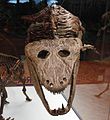- Mastodonsaurus
-
Mastodonsaurus
Temporal range: Middle Triassic
Mastodonsaurus torvus Scientific classification Kingdom: Animalia Phylum: Chordata Superclass: Tetrapoda Class: Amphibia Order: Temnospondyli Superfamily: Capitosauroidea Family: Mastodonsauridae Genus: Mastodonsaurus
Jaeger, 1828Species - M. jaegeri (type)
- M. cappelensis Wepfer, 1923
- M. giganteus
- M. torvus Konzhukova, 1955
Mastodonsaurus (meaning "breast tooth lizard") was a large-headed temnospondyl that belonged to a group of advanced, mostly Triassic amphibians called capitosaurids. It was a giant among the stegocephalians and the largest animal of its time (late Triassic, 200 MYA). It looked like a huge frog, but instead of being semicircular, as in frogs, its head was triangular and reached 1.25 m. in length, the total length of the animal would be about 4–5 meters. The large, oval eye sockets were midway along the skull. The jaws were armed with conical teeth. The body was relatively small in proportion to the large head, and the tail was very short. The greatly reduced limbs had cartilaginous carpal and tarsal joints. The marked reduction of the limbs and the sinus lines on the head show that Mastodonsaurus was an aquatic animal which hardly ever left water. It inhabited swampy pools and lived mainly on fish, whose remains have been found in its fossilized excrete (coprolites).[1] It probably also ate land-living animals, such as small archosaurs. The fossils of some smaller temnospondyls bear tooth marks made by Mastodonsaurus-like animals.
According to some scientists, Mastodonsaurus was completely unable to leave the water, and this option is borne out by finds of large quantities of bones showing that in times of drought, when the pools died up, these creatures died en masse.[1]
Mastodonsaurus was once thought to be responsible for the footprints found in Triassic sandstones and described as Chirotherium, but more recent research had found that the tracks belong to lizard-like reptiles of the Pseudosuchia group.[1]
Recent studies have shown, however, that its body was less compact and the tail much longer, giving it an overall-appearance much like a crocodile. Two triangular tusks pointed up from near the tip of its lower jaw. When the jaws closed, these slotted through openings on the palate and projected through the top of the skull.
Species
A large number of species have been attributed to the genus over the years. However in a reexamination of the genus by Markus Moser and Rainer Schoch in 2007 only three of the species were determined to be valid. The type species M. jaegeri, the best known species M.giganteus both from Europe, and M. torvus from Russia. The species M. acuminatus was shown to be a junior synonym to M. giganteus, while the species M. tantus& M. maximus were both determined to be synonyms to M. torvus.[2]
The species M. andriani, M. indicus, M. laniarius, M. lavisi, M. meyeri, M. pachygnathus and M. silesiacus; reexamined by Moser and Schoch; were not assignable to the genus Mastodonsaurus due to the fragmentary nature of the type specimens and as such are considered nomen dubium.[2] Examination of the literature showed M. conicus to be a senior synonym of the genus M. ventricosus, however this species was never formally published and is considered nomen nudum.[2]
Several species have been reassigned to other genera over the years. The species M. cappelensis was moved to he genus Heptasaurus as the type species of the genus with the species M. ingens considered a jr. synonym and M. vaslenensis is considered as a possible heptasaurid.[2] In similar situation M. granulosus is now Plagiosternum granulosus, M. arenaceus is now Capitosaurus arenaceus, and M. robustus is now Cyclotosaurus robustus with M. cyclotis as a jr. synonym.[2] Another species renamed was M. durus which was reassigned as Eupelor durus, however this species is considered nomen nudum, with the type material only listed as indeterminate metoposaurid.[2] One species, M. keuperinus was determined to be based on a mix of indeterminate metoposaurid and mastodonsaurid material.[2] M. weigelti is now considered a jr. synonym of the species Parotosuchus nasutus.[2] Mastodonsaurus leptognathus is not a valid species with the type specimen considered possibly belonging to he species Stenotosaurus stantonensis instead of Mastodonsaurus.[2]
Gallery
-
Illustration of Mastodonsaurus and Rhynchosaur, 1894
References
Kingdom: Animalia · Phylum: Chordata · Class: Amphibia · Order: Temnospondyli · (unranked): Limnarchia · (unranked): Stereospondylomorpha Suborder: Stereospondyli Heylerosauridae Mastodonsauridae Calmasuchus · Cherninia · Cyclotosaurus · Eryosuchus · Jammerbergia · Kestrosaurus · Paracyclotosaurus · Parotosuchus · Mastodonsaurus · Rewanobatrachus · Subcyclotosaurus · Tatrasaurus · Watsonisuchus · Wetlugasaurus · XenotosuchusSclerothoracidae Stenotosauridae Related categories Temnospondyls · Triassic amphibiansCategories:- Temnospondyls
- Triassic amphibians
- Prehistoric amphibian stubs
Wikimedia Foundation. 2010.




